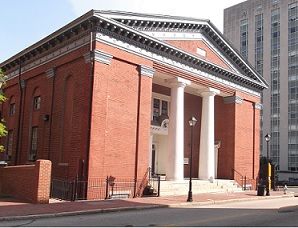 Unfortunately for the preservation of Virginia’s African American history, Richmond’s Mayor, a man of color and the book, is either morally corrupt or benignly ignorant. Doesn’t matter which, the result may be the same. It is not surprising that a typical American does not value the history of a place.
Unfortunately for the preservation of Virginia’s African American history, Richmond’s Mayor, a man of color and the book, is either morally corrupt or benignly ignorant. Doesn’t matter which, the result may be the same. It is not surprising that a typical American does not value the history of a place.
But failure to grasp his own heritage is a mortal flaw. There are a few stories here. The ground under Shockoe Bottom is one. The legacy of what went on there and in Jackson Ward and throughout Richmond is another. That legacy screams for every effort to remedy the high unemployment among blacks in Richmond and the accompanying fratricide. A properly funded and directed school system and full-time employment opportunities should be job one. Instead, places for games that feather already well-healed nests and half million dollar studies of half-cocked ideas consume Richmond City revenues. Great photo ops, though.
“…we are totally opposed to a stadium in Shockoe Bottom. Agreeing to this demand by Mayor Jones and the developers he represents would clearly state the following position: Yes, the history is important, but not so much that we can’t play games on top of it. And that would be a continuation of the same disrespect that formed the basis for the acceptance of slavery and the slave trade in the first place.” – statement by Phil Wilayto and Anna Edwards of the Sacred Ground Project
Compound this with the arrogant, aloof stance that Richmond is immune from federal Section 106 regulations which is even more insulting than any tea party nullification rant. If Jones were Mayor of Jerusalem, he’d solve that whole Temple Mount thing by razing both al Aqsa Mosque and the Dome of the Rock then build condos and concessions surrounding a miniaturized, motorized laser show of popular myths: Abraham and alternating sons; Moses (I know, I know, but authenticity is not important) delivering an Ark of the Covenant emanating lightning bolts; Jesus in a fit turning over tables; Mohammad gliding in on his horse; you get it, something for everyone.
Maybe the race to succeed Virginia state Senator Henry Marsh (D-16th) whose former district includes much of Richmond’s East End will provide a vehicle for Delegates McQuinn (D-70th), whose current district encompasses less and Dance (D-63rd) whose current district covers none to help crystalize the debate. McQuinn seems to be able to straddle both sides of the issue, which hasn’t been helpful and could make it quite a tango for Dance. Both probably believe Jones’ endorsement would be to their advantage in the contest. In reality, electoral influence is likely the only reason any politician patronizes Jones. Developers seem to believe there are other purposes.
And developers have much to fear if Section 106 is enforced. That could keep those bulldozers and backhoes at bay for quite a long time; maybe ever. It takes a very long time to properly excavate a site. The truth is that there is no generally accepted agreement on what was where in the Bottom and surrounding areas. Section 106 requires significant archeological work to be done before digging in an historic spot. But beyond a federal regulation, those who value the history and legacy should demand it. Below the ground is an undisturbed layer of history that cries for discovery. That is a painstaking task that will proceed street by street, block by block, sometimes using spoons and small brushes.
“As I view it, in an unenlightened age, 100 years ago, we built a train station on top of this history. And then 50 years later, still in an unenlightened age, we built an interstate highway on top of this. And now we’re talking about, in an enlightened age, new large public works right on top of this. Instead, we should maintain the street grid. We should do the historical exploration and research. We should do the archeology. Delores, I hate to disagree with you. You said we can’t dig up the whole Bottom? We are going to dig it all up. We know we’re going to dig it all up. So, when you dig, look at what you’re digging.” – S. Wait Rawls III, Co-CEO, American Civil War Museum
Much of the discussion about how to preserve the history in the Bottom diverges along two tracks. One focuses on modern buildings, the other on creating a sense of place. Fortunately that place is among the least developed in the city, leaving flexibility to create an historic district that weaves what are now relatively disparate attractions into a Richmond theme. A real issue is that history has slowly been seeping out of the ground for just a couple of decades and the whole story is untold. So constructing a modern facility without knowing what it might contain in the end seems a dubious concept.
Further, this effort should result in something unique; not just a replica of facilities in other places like Charleston or Cincinnati whose stories are different and, frankly, less compelling. More than half of the African Americans in America can trace their lineage back through a three block area of Richmond. New Orleans may have been a larger slave center by the 1850s, but Richmond dates back into the 1600s. And something not mentioned in the discussion just yet, Virginia was a net exporter of slaves born and raised here even before the 1850s; yes to New Orleans. This is a whole other story that must be addressed and in fact is a women’s issue that has been largely ignored. The Richmond story offers a rich history few other places can claim in the Americas and can be a unique international treasure.
“In Shockoe Bottom there is the burial ground, Lumpkin’s jail and the evolution into Virginia Union University. There is also the First African Baptist Church and Jackson Ward where Africans coming out of the enslaved era to raise up families, businesses, churches, and institutions all in a compact 4 square mile area. And further away was the Wall Street of the slave trade.” – Delegate Delores McQuinn
Shockoe Bottom provides an opportunity for a critical mass weaving a comprehensive tale that speaks to web-based and wired generations. Part of that story should include the unravelling of history and the archaeological methods used to uncover the mysteries that span time and events that lay under the surface of the ground there. That itself is an expensive and time consuming effort. The excavation at Lumpkin’s Jail carried a price tag of $750,000.
According to David Ruth, Superintendent of Richmond National Battlefield Park and the Maggie L. Walker National Historic Site, this can be a place where the conversation is not just about the past but what it means to those today and how it can improve the future. The hopes, the dreams, the aspirations, and even the fears of those who come into the experience. A dynamic encounter that moves people and drives them to do something. A site of conscience that moves beyond historic interpretation and to action. Shockoe Bottom can become a unique, enduring American cultural focal point.
Or, it can be a baseball park.














